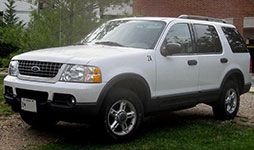The Ford Explorer has a long history, with plenty of changes, but what are the differences between the generations on this SUV? We’ll take a look at some key areas in each generation to give you a better idea.
Key takeaways
- If you’re wanting a three door Explorer, you’ll have to opt for a first or second gen.
- In the fourth gen, the Explorer gained a new chassis, making for a sturdier design, also being safer than previous generations with the addition of curtain airbags.
- The fifth gen sees the addition of more modern features and another high-end trim.
Are you in the market for a Ford Explorer but don’t want something new? Let’s look at some of the older generations and see why old is sometimes gold.
For the Ford Explorer there’s some history behind it, initially filling the void that the Bronco II left all the way back in 1991. The Explorer has since seen plenty of changes, and facelifts to bring it into the modern era.
First generation (1991-1994)

The Ford Explorer hit the market in 1991, and while it was a new model, it looked a lot like the Ford Ranger as it was still trying to find its place in the market. This generation saw 4 trims, depending on the configuration you have, with a luxury trim coming out in 1993.
If you have the 5-door configuration you can look for the XL, XLT, and Eddie Baurer trims. If you have the 3-door trim you can look for the XL, Eddie Baurer, and Sport trims.
The Sport Trim came with black lower bodywork, grille, and standard alloy wheels, and was later renamed to Mazda Navajo, with its first year on the market it became the first SUV to win Motor Trend truck of the year, setting the stage for the rest to come after.
The 1994 trim is when the Explorer really started to find its footing with the Limited coming with nearly every available feature that was on the first gen as the only options were a sunroof, compact disc player, and towing package. Some of the features that the Limited came standard with are an anti-theft system, keyless entry, and automatic headlights.
Second generation (1995-2002)
This generation brought in the new millennium, and brought even better features to the Explorer family. The Explorer received a redesign to help give the model its own identity, and despite getting a new look, it didn’t really change much besides all three-door Explorers becoming Explorer Sports in 1999.
Third generation (2002-2005)
This generation received its first complete redesign, and being that the 5-door model was selling better than the 3-door, it became the only Explorer available in the third gen.
This year the lineup came with a handful of trims, with the XLS being a fleet trim, and the XLS Sport that standardized many options the XLS came with. If you’re looking for more than fleet trims, then you’re covered with the third gen offering XLT, XLT Sport, Eddie Baurer, and Limited trims.
The XLT Sport is a new trim, that comes with a gray lower-body trim and 17-inch wheels, and for 2003 and 2004, Ford added the Explorer NBX, meant to be an off-road Explorer, with all-terrain tires, black bumpers and body cladding, heavy-duty roof rack, and custom seat trim.
Fourth generation (2006-2010)
As we get closer to the modern generations of Explorers, the features and build get much better. For the fourth gen, Ford decided to swap what company made their frame, and in doing so it made the chassis stronger than before. This generation also saw an updated interior, as well as a redesigned rear suspension, giving a smoother ride than the previous generations.
This generation also saw the addition of a tire pressure monitoring system and electronic stability control that became standard. In 2007, the Explorer saw the addition of aux ports across every stereo, in 2008 Ford gave all Expedition trims the addition of side curtain airbags, and in 2009 the Explorer received a trailer sway control system as standard equipment.
Fifth generation (2011-2019)
This generation continues the momentum from before, coming with a ton of new features. A few standout ones were a dual headrest DVD entertainment system, power liftgate, remote engine start, and adaptive cruise control.
In 2016, the Explorer saw a new trim enter the lineup as it received an update in the same year. For the update, you can look for a new engine that came from the 2015 Mustang, this engine is a 2.3 L EcoBoost four-cylinder engine that takes the place of the I4 engine, and the new trim is the Platinum trim.
The Platinum trim is the new highest trim level, coming with front and rear cameras, enhanced active park assist with perpendicular park assist, and a hands-free liftgate, this trim also comes with a 3.5 L EcoBoost twin-turbo V6.
Sixth generation (2020-Current)
This is the most recent generation for the Explorer, coming in 4 trims, XLT, Limited, ST, and Limited. In mid 2021, Ford added the Timberline trim based on the mid-level XLT, added unique heathered cloth and ActiveX trimmed seating surfaces, all-terrain tires, and unique exterior and interior styling details.
When 2022 came around Ford gave the Explorer a rear-wheel drive version of the Explorer ST, as well as a hybrid version of the Platinum.
A new ST-Line trim also came with this refresh, the ST-Line comes with a 2.3-liter EcoBoost inline four-cylinder engine, also a Bang and Olufsen premium surround sound audio system.
Final thoughts
When it comes to the Explorer, it went through many changes to get to where it is today, but we’re thankful for it. This SUV is a modern classic. Come see us at Jarrett Ford to check out our inventory.